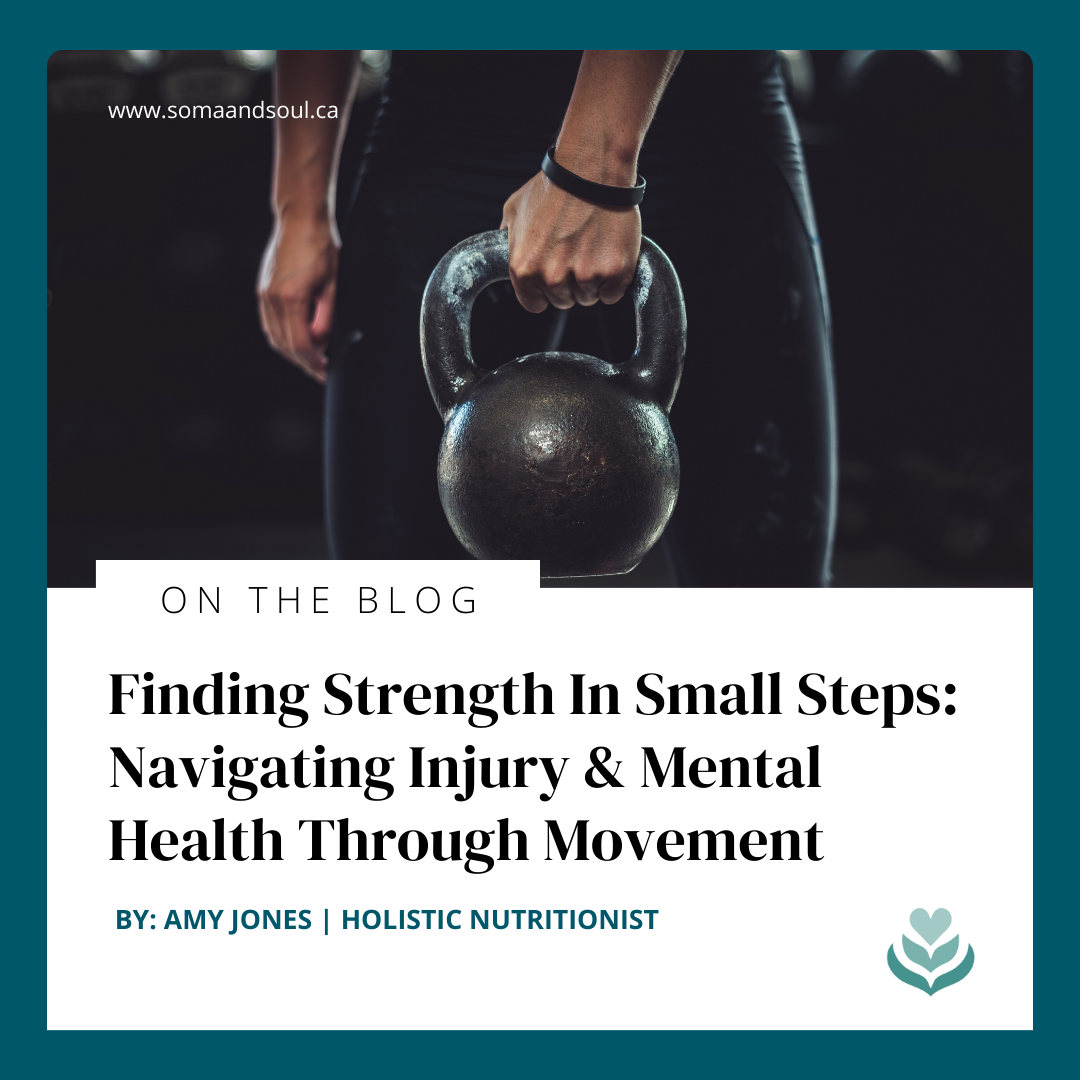I’m an avid lover of physical activity, especially resistance training and opportunities to challenge my physical limits (I finished my first Spartan race this year), but, encountering an injury that restricted my movement was a seemingly unbearable challenge for me.
I’ve been battling a torn labrum (in my hip) since my days of kickboxing (about two years ago) and it flares up once in a while. This setback wasn’t just about the physical limitations; my mental and emotional well-being are deeply intertwined with my ability to move freely.
This unexpected pause in my active lifestyle has brought a new understanding of how vital movement is for mental health, particularly in managing conditions like ADHD and anxiety.
In this post, I’ll walk you through my journey of recovery, the importance of listening to our bodies, the science behind movement and mood balance, the role of nutrition in movement and delicious, movement-supporting and nutrient-packed breakfast recipe.
The Path To Recovery: Small Steps Matter
This week, I’ve been finally able to begin a gentle walking routine. I took advantage of the gorgeous fall weather and enjoyed walks on the boardwalk near Lake Ontario and on my way home, stopped at our local shops to check off my list of errands. After weeks of struggling with intense pain and very limited movement, the feeling of freedom as well as appreciation for my body’s capabilities has been profound.
This experience has been a stark reminder of the significant role physical activity plays in not just physical wellness, but also in maintaining mental balance.
Movement, for me, is so intertwined with my ability to think clearly, self-regulate and embody a sense of strength and confidence to tackle the challenges of motherhood and my career.
In the next week, I’m looking forward to adding more upper-body strength training along with the lower-body exercises prescribed by my chiropractor and physiotherapist.
But, let me tell you this:
Pain is no joke.
I’ve had a few people say, ‘Can’t you just do upper body workouts?’
Actually, for me – no way. If you are doing resistance training correctly, it involves every part of your body – and at the pinnacle of my pain, there was no way any of that was happening.
Those of you who are reading this right now and want to tell me that through this injury, my body is telling me to take a step back from my rigorous routine – I hear you.
Your wisdom is not lost on me. I’ve been pushing very hard, for a very long time.
I know it’s important to take breaks, recover, and give your body time to restore itself – but, I’ve never been very good at this (those who know me would say that’s an understatement).
Rest assured, body, I’m listening now.
The Scientific Link: Movement, Mental Health & ADHD
For us adults, especially those juggling life with ADHD, regular physical activity isn’t just a nice-to-have; it’s a must-have. It’s like a daily dose of brain food, enhancing cognitive function – attention, memory, and the ability to switch gears effortlessly.
For our kids, especially those navigating the world with ADHD and anxiety, regular exercise is one of the keys to unlocking their potential. It significantly boosts their ability to focus, calms down hyperactivity, and elevates their performance in school.
Physical activities that require coordination – like team sports – are especially beneficial. They’re not just exercises; they’re interactive sessions where both the mind and body are engaged and nurtured, fostering a simultaneous development of cognitive and physical skills.
Our family recently spent an amazing hour at One Academy in Leslieville Toronto – taking advantage of their incredible coaches and an opportunity to challenge my boys’ understanding of their own physical capabilities. It was a transformative experience for all of us. You can watch the reel here.
Movement for Mental Health: The Necessity Of It All
Stress Reduction: A Biochemical Shift
Physical activity triggers a remarkable biochemical transformation in our bodies. When we exercise, we initially experience a spike in stress hormones like adrenaline and cortisol. However, this is quickly offset by the production of endorphins, the ‘feel-good’ hormones, leading to a reduction in stress levels. This process lowers the volume of stress, providing our minds with a sense of calm and relief. Studies confirm that regular exercise significantly decreases stress hormones and increases endorphins, culminating in a post-exercise “runner’s high” – a state of relaxation and uplifted mood. This shift from stress to serenity demonstrates the incredible impact of exercise on our mental well-being.
Improved Sleep: Harmonizing Our Internal Clock
Regular physical activity plays a pivotal role in regulating our circadian rhythms – the internal processes that govern our sleep-wake cycles. Exercise, particularly when timed correctly during the day, enhances the quality of sleep by promoting deeper sleep phases and reducing the onset time of sleep. Studies show that those of us who exercise regularly experience better sleep quality and are less prone to insomnia. Sleep, in turn, is a critical component of mental health, affecting everything from mood regulation to cognitive function.
Enhanced Brain Health: Neurogenesis and Beyond
Exercise also increases the production of neurotrophins, such as Brain-Derived Neurotrophic Factor (BDNF), which play a crucial role in the growth and survival of neurons. This process, known as neurogenesis, contributes to a more resilient and adaptable brain. Furthermore, regular physical activity has been shown to improve cognitive functions like memory, attention, and problem-solving skills. It also enhances the brain’s plasticity – its ability to change and adapt – contributing to overall mental agility and health.
Key Nutrients for Mental and Physical Health
Protein:
Beyond muscle repair and growth, protein is incredibly important for the optimal functioning of neurotransmitters, the brain’s chemical messengers. Amino acids, the building blocks of proteins, are precursors to neurotransmitters like serotonin and dopamine, which play key roles in mood regulation and cognitive processes.
Omega-3 Fatty Acids:
These essential fats act as critical components of cell membranes in the brain, influencing the fluidity and functioning of neuronal membranes. Omega-3s, particularly EPA and DHA, are known for their role in cognitive health and mood stabilization. Their anti-inflammatory properties also contribute to overall brain, joint and cardiovascular health.
Vitamin D:
Often overlooked for its function in movement, Vitamin D is vital for more than just the immune system & bone health. It’s involved in muscle function, brain development, and the regulation of mood. Vitamin D receptors are present in many areas of the brain, and their role in neurocognitive functioning and mental health is increasingly recognized in many recent scientific nutrition-based studies.
With this understanding of the importance of key nutrients to support movement, I want to give you one of my favourite nutrient-packed breakfast recipes to support lean muscle growth, mood stability and our innate human desire for delicious food! Find the FULL RECIPE on our blog here.
My journey, so far, has been a challenging one.
I’m doing my best to listen to my body, listen to my heart, listen to my mind and the needs of all three to find the next steps forward.
Whether it’s navigating the challenges of ADHD, managing stress & anxiety, or finding strength in the face of physical limitations, for my entire life, movement continually proves to be an essential ally in my journey.
Every small step forward counts.
Amy Jones
BA Hons., B Ed., RHN, CNE, OCT
Metabolic Balance® Coach
Intuitive Eating Counsellor Candidate
Care-Informed & Health At Every Size® (HAES®) Nutritionist




